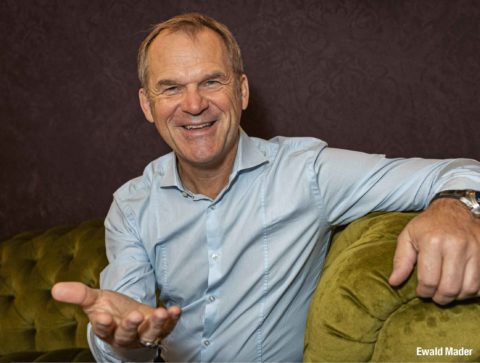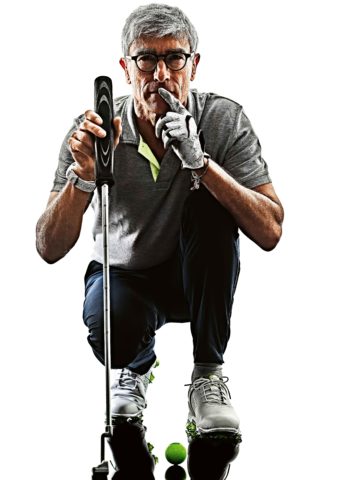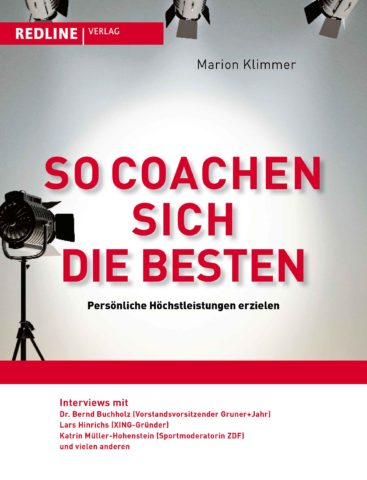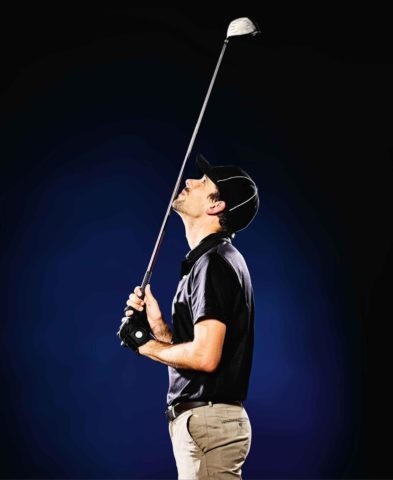The problem with the head
A self-experiment in terms of golf mentality
When the image of a real guy, who is professionally chasing criminals in a special police unit, stands trembling on an easy par 4 and then notes an 11 on the scorecard (with HC -9.5), the mental aspect of golf has again slammed in full hardness. This is what happens in an average team game in an average league class. With a few exceptions, our golfers’ heads permanently put a damper on the competition bill.
Would you like more examples? Just take a look at the monthly result lists of the team competitions in your state. Or take a closer look at the results of the monthly cups, club championships and sponsor tournaments – golfers of all handicap classes regularly stay well below their playing skills.
It happened to me again this year at the club championships. For two laps “steered” instead of “swinging”. Only in the last lap was a passable performance that made me squint for a lap result of 10 over par. Until the 18th. Then the head turned on in the form of the so-called amygdala. Put simply, this area in our brain is responsible for controlling our breathing and heartbeat. The amygdala is also connected to the body’s motor system. In the case of strong emotions, such as fear, the amygdala starts its very private stress program. In retrospect, the situation at 18 must have happened as follows:
In the case of strong emotions, such as fear, the amygdala starts its very private stress program.
-> Eye on the almond kernel: “Club terrace full, everyone is watching.”
-> Understanding of almond kernel: “Good round so far, don’t screw it up, calm down.”
-> Eye on the almond kernel: “185 meters, water to the left and a stormy headwind.”
-> Ego on almond kernel: “Iron 2, slightly faded, relaxed in the wind.”
-> Understanding of almond kernel: “I haven’t played 2 iron all day.”
-> Ego to mind: “Shut up, I can do it, let’s do the fat one.”
Almond kernel – now flashing like a disco ball – increases breathing and pulse rate dramatically, provides wooden muscle contraction and switches to golfer mode »Panic«.
The ego finally won the duel with the almond kernel and the panic swing resulted in a topped semi-socket with a good 45 meters of taxiing. I spare my long-term memory the further blows, especially since I have just learned in my self-experiment that looking back is not really worth it. Therefore only briefly the chronicler’s duty: The ball lay bad in the high rough, the second shot went into the pond in front of the green and the fourth then over the green. Chip and putt got me a six, with which I was still relatively well served.
So it’s high time to take a closer look at the topic of “golf and mental training”. I met two mental coaches who have an interesting vita and a well-known reference in the business and sports area:
Author Marion Klimmer

focuses on self-coaching instruments based on the secrets of success of numerous professional athletes, founders and board members. She herself comes from the business world and has held numerous positions as a specialist and manager. In individual coaching, she uses efficient methods to dissolve emotional and mental blockages and to make fears or phobias disappear. The so-called »wingwave®« is an effective means of doing this. She lives and coaches in Hamburg and online.
Book author Ewald Mader

made a first statement in terms of self-help for golfers with the book “Are you still thinking or are you already golfing?” In his latest work, “The Path to Top Golfer”, he deepens and specifies the instructions for successfully relaxed golf. Ewald Mader is very pragmatic and can look back on an extremely successful professional career in which he founded and led a successful IT company. The father of three sons now runs his own foundation and lives with his partner, who is a qualified psychologist, in Berlin.
Getting to know different techniques was in the foreground of the self-experiment, because I had already read enough books on the subject. What bothered me about many publications was that they only contained a list of things that should be written behind the ears and rarely specific instructions on how I can work on myself.
In both appointments, the anamnesis is of course in the foreground: Where are the problems? Where is the level of suffering highest? What do you want to work on?
In the first coaching, Ms. Klimmer relies on the myostatic test, an interesting method that has even been further developed by the Cologne Sports University. The test can be summarized as follows: I keep my thumb and middle finger pressed against each other as hard as I can. The coach then asks me a few questions and checks immediately after each question whether he can easily separate his fingers. If so, it is an indication of a stressor. For someone like me to whom things have to be explained practically, it’s exciting to see how easily this tool works. When I say: “I am currently in coaching with Ms. Klimmer”, she cannot loosen her fingers. But if I say, “I’m sitting on the moon right now,” she loosely loosens her fingers. Since our cognitive and mental processes mainly take place in the cerebrum, mental stress is shared particularly quickly in the hand muscle, as it is disproportionately active in this area. That is the secret of the test.
The result is that I probably don’t like being the center of attention and that I largely judge my own impact on other people. Of course, that doesn’t go well with a tee shot in front of the Ryder Cup backdrop, so let’s tackle the problem:
We develop a suggestion text that serves as self-image coaching and positive belief and implement this in a first wingwave® session. Wingwave® is described in popular science as a method for performance and emotion coaching that is based on simulating the REM phases, ie the dream phases at night, while awake. We move our eyes back and forth very quickly during these REM (Rapid Eye Movement) phases. It is assumed that we use these REM phases to process experiences and that parts of them are stored in long-term memory. In order to get into the state of the dream, the coach moves his fingers back and forth quickly in front of the eye and the experienced situation is played through again with a target-oriented suggestion text. The whole thing doesn’t take long, you are fully conscious and reach a subconscious level that would not be possible without stimulation. Exciting.
The second appointment with Ewald Mader takes me into the world of hypnosis. Up until a few years ago, the word hypnosis caused a blockage for me, especially since I always thought that one would be completely “gone” during hypnosis. But you are not. You are more in a twilight state where you can stop at any time. I had experience with this type of therapy years ago, so I went into my “golf hypnosis” expectantly.
With hypnosis it is possible for the hypnotist to accompany his counterpart in the subconscious. Under hypnosis, the patient can look at events that remain blocked in his consciousness. Example: If you were overwhelmed at the age of eleven because, for example, your father collapsed before you as a medical emergency, you can go into this situation again under hypnosis as an adult and manage it more calmly. You “overwrite” the program saved on the hard drive, so to speak, and the effects of this decades-old experience, which were expressed in the fact that you later showed physical symptoms yourself when relatives became ill again, will disappear.
The journey through time to oneself seems to be a very popular way at the moment, because the book “The child in you must find home” has been in the top 3 of all bestseller lists (Spiegel, Stern and Amazon) for many months .
The anamnesis is also in the foreground at this appointment. We look for conscious patterns of action and their effects. When do you get nervous? What prevents you from swinging just as relaxed on the court as on the range? In which game situations does this occur?
In hypnosis, we take a journey through the years of life and look at events that could act as emotional disruptive factors. I, or rather my subconscious, come across minor incidents that everyone probably carries around with them. Situations in which one was exposed to danger, one was teased or in which one was threatened with loss. All of them not dramatic, but interesting that I examine exactly these incidents in more detail and then look at them from a different perspective – and thus reprogram. Mr Mader moderates the hypnosis in such a way that he brings me back to reality with a good dose of relaxation and increased trust. Wow!
In the conversation again, he explains to me that almost every professional athlete coaches himself with hypnosis. For Tiger Woods, self-hypnosis has been part of his mental toolbox since he was a child. Hypnosis with a coach is actually only necessary for the first discovery of the stressors; later you can coach yourself with self-hypnosis with suggestion texts that are tailored to the problems of the respective student.
At the end of the coaching with Ewald Mader, Marion Klimmer joins us again and in a double interview with both of them I find out that I have to put together my own small toolbox from the multitude of mental coaching tools. This has to be learned and used, over and over again, because mentally nothing works by itself.
interview
I understand that I can use »wingwave®« and hypnosis as a solution tool for my individual problems. Also that this is not done with one session, but that you have to stay on the ball. But what options do I still have?
-> Ewald Mader: The aforementioned »staying on the ball« is a key to success. The brain works in the same way as a muscle. You will achieve little success with a single practice. Constant repetitions and adaptations bring the desired success in the long term.
-> Marion Klimmer: The two tools hypnosis and wingwave® should be viewed as individual tools in your small tool box. There will always be moments when you need mental aids adapted to the situation. But first, you should start setting meaningful goals for yourself. These goals then act as guiding principles. The emphasis is on “meaningful and accessible,” because our brains aren’t stupid. If you put winning the Masters in Augusta as your guiding principle with a handicap of -14.5, it won’t work.
So what instead?
-> Klimmer: If you start from -14.5, a sensible goal would be to play mostly relaxed, nice rounds under 90 for the next year. The goal should always be formulated realistically achievable.
-> Mader : It should also be motivating and positive. Just no negative formulations and negations like: “I no longer want this or that”. Our brain cannot do anything with that. Do not over- or under-demand yourself in the formulation of goals, because this will expose you to either stress or boredom.
Speaking of boredom. Mr Mader, I read from you that golf only gets really good when it feels boring. You call it procedural golf.
-> Mader: There are optional and procedural ticking people. An optional ticking person is more likely to perish on an assembly line because he is always looking for new options and challenges. Conversely, a procedurally ticking person feels right at home in the routine. Have you ever played a really good round? In doing so, you will have noticed that you didn’t give much thought to this or that option – you got into a procedural flow. You have repeatedly called up the same saved swing pattern without thinking too much and trying out new options.
 The flow is an important term.
The flow is an important term.
In fact, on very good laps I had the feeling that I had everything completely under control. No chance of 3 putts or warped wedges. Above all, no swing thoughts. Why do you as an amateur rarely get into this flow?
-> Mader: That has to do with a lack of practice. Professionals try to play in this flow all the time. Many only play badly when they are not in the flow. The professionals have been training to get into this state since they were young. The flow is nothing other than being completely in the here and now. Golf is a game of the present, not the future or the past. Most recreational golfers hang on to strokes for days and weeks and then think about these failures in the future (“just don’t hit here and there again”).
And how do I get there? How can this state be achieved?
-> Mader: Turn off disruptive factors. Practice moving only in the present. In flow, you play golf without your mind, your brain is in what is known as the calm alpha wave state. The mind that sends beta waves is turned off. And that’s good for the golf swing, because we control the intuitive movement sequences with the right hemisphere.
By the way, we also sign with that. Sign slowly with an exaggerated amount of time. And? Became very spooky and wooden! You have now signed with the left hemisphere, which is responsible for the mind, on slowness. Driving and cycling work similarly. Once learned (left brain hemisphere) it is stored in intuition (right brain hemisphere) and you never have to think about it again.
-> Klimmer: So it is a good advisor to silence the thinking half of the brain.
How exactly?
-> Klimmer: Martina Eberl and her caddy always chose a specific topic for the 18 holes and discussed it with him on the round. This left her with less chance of concentrating on how she was doing technical results or how she was taking punches. Annika Sörenstam counted backwards before strokes and then mumbled »Fairways & Greens« to herself. By counting, she kept the processor of the thinking hemisphere under load so that it does not interfere with intuition.
And do everything calmly in the preparation. Beta waves emanate from calm. Take your time, listen to calm music, walk slowly and relaxed. Have you ever seen a professional soccer or golf player running from the parking lot to the stadium or to tee 1 in a hurry? No chance! So they creep slowly with beautiful music on their ears …
Mr. Mader, who is the “Inner Critic” that you describe in your book?
-> Mader: Every golfer probably knows that. That is the voice that speaks everything badly. Negatively emotionally charged events are fed as an endless loop in self-dialogue on a round. This includes the typical “yes, but”. A blow commented positively by a teammate is immediately destroyed with a “Yes, but I didn’t hit the way I wanted”. And it is the most difficult to change metaprogram that runs in humans. You have to train that with positive beliefs. The inner critic is so widespread that I hardly ever see golfers on golf courses, but almost only inner critic (laughs). Seeing the positives is hard, but you have to train hard. With positively formulated beliefs à la »loose, straight and wide« before each stroke. And work with visual beliefs too. For example, I have an exaggeratedly cool picture of myself in which I walk very upright to the tee with sunglasses. I put that in a picture of the bulging tee 1 area at the Ryder Cup. I look at it every day and then at some point I believe myself. This is what professionals in all sports do.
You also write of “setting anchors,” which can be called up when needed. What do you mean by that?
-> Mader: Pay attention to the professionals. Jason Day, for example, always slightly closes his eyes before the blow and his eyes seem to flicker. He does that especially under pressure. There he realizes a small wingwave® in which he has saved an anchor such as “swing calmly”. He has “inoculated” this into himself beforehand using autosuggestion and after it has been saved, he can call it up in pressure situations. Almost all athletes do that. Often these anchors are dismissed as “crazy” or “quirk of the athlete”, but this is one of the ways to get into the flow or to survive pressure situations.
So in summary it can be said that it does take a little work to mentally put together a personal toolbox.
-> Klimmer: Absolutely. You must first identify in yourself what your correct beliefs could be, then silence the inner critic and train the correct mental techniques in order to be able to use the tools.
-> Mader: There are many instructions for self-help in our books. Very pragmatic, but that would not have fitted into your interview time. It’s about how you can learn which practice yourself. It ranges from range tips and test swings to simulations and emergency programs. Simply and briefly described.
Why do so few German players make it on the two big tours in Europe and the USA, even though Germany plays a very important role in the youth field? A question to which I have not had a satisfactory answer for a long time. It can hardly be because of the conditions and the number of golfers that Finns, Danes and Swedes play up front every year. Not to mention the Italians and Spaniards, who have far fewer golfers than Germany. Is that justified mentally?
-> Mader: I would say yes. I am familiar with the DGV training plans and believe that mental training is underrepresented. I also suspect that other countries are focusing on competition-oriented training. Perhaps we are too “cerebral” and think too much in terms of swing levels. That would be a possible justification, but it is difficult to judge from the outside. Those responsible would have to investigate the exact factors. I find the question exciting!
So I already have an answer for our team captain, who is collecting ideas about what should be trained and how in the new season. Ms. Klimmer, maybe a short closing word from you? What is really the most important thing for us golfers to make mental progress?
-> Klimmer: We should stop counting and worry about what the others think of us! This deeply human fear of external impact is really a hindrance in golf. You can and should work off that. Only then can the amygdala calm down with you in the long term.
Thank you both!
Book tips
Ewald Mader: “Are you still thinking
or are you already golfing? “

Verlag Menschen Großmachen, 262 pages
Are you still thinking or are you already golfing? Leave your golfer’s brain unattended! Handicap single digit or plus! If you want to know how you can bring your handicap to a plus, then you should definitely read this book. Reading is a must for all those who develop expertise and want to be successful, and permanently. But also simple, directly applicable methods for every handicap are discussed, whereby the author provides a lot of background knowledge. The special thing about it: Ewald Mader addresses not only the extrinsic but also the intrinsic motivation and inspires the ambitious reader to use mental training to reflect on their inner powers and self-confidence. »Mental knowledge and directly applicable methods for golfers, regardless of their handicap. And the inner doubter is finally still in the head. «Verlag Menschen Großmachen, 262 pages, golfcoachmental.de
Ewald Mader: “The path to becoming a top golfer”

Verlag Menschen Großmachen, 164 pages
This book with an overview poster will get you to use mental techniques immediately. You can get started right away. Everyone conducts an inner self-dialogue. Self-talk in the form of affirmations and suggestion texts are the simple and essential introduction to positive self-talk for better performance in golf. This applies to newcomers as well as “old hands” who first have to turn the “inner critic” before the next handicap level can be reached. For competitive golfers and professionals, self-talk is a matter of course. In addition, mental fitness is very powerful. Because in a resourceful state, to complete tournaments, filled with calm, concentration and self-confidence, means a higher performance potential and greater resilience to stress. Here, too, the poster contains direct instructions on how to use anchors, eg a resting anchor, or provides you with a breathing technique that you can use to “calm down”. These are essential for every golfer not only in pressure situations. If you want it to be even easier and more direct, you cannot avoid the use of hypnosis, as the really big ones in sport, e.g. Tiger Woods, do. In this book you will find a hypnosis text for your own use – to “improve performance” – with which you can let your subconscious work comfortably for you. The application of mental training couldn’t be easier. Verlag Menschen Großmachen, 164 pages, handicap-golf-verbessern.de
Marion Klimmer: “This is how the best coach each other”

Redline Verlag, 280 pages
Stomach pains before exams, excitement before important presentations, trembling hands when teeing off – it is difficult to achieve your own maximum performance in stressful situations and to call it up exactly. Marion Klimmer shows in a neuroscientific manner how stress arises and how it can be dealt with with professional self-coaching. The reader learns how obstacles to success are identified and emotional blockages are resolved – the prerequisite for situational top performance. With methods like »wingwave«, »Reiss-Profil« and many others, exam candidates, top athletes, managers and private individuals find their emotional and mental balance in exam-like situations. In addition, 28 top performers reveal their personal high-performance strategies in interviews: ZDF sports presenter Katrin Müller-Hohenstein tells, for example, how she is preparing for an important international football match. XING founder Lars Hinrichs explains how he deals with pressure and Martina Eberl reveals the tricks she uses to win tournaments as a professional golfer. Redline Verlag, 280 pages. Klimmer-coaching.de
Bob Rotella: “The 15th Bat”

Copress, 192 pages
Every golfer can have 14 clubs in their bag, but the real winners have a little more with them – a mental attitude that makes them play better than everyone else. Dr. Bob Rotella, author of the successful title “The Golf of Your Dreams”, summarizes his experiences as a golf psychologist in this book and tells every player how he can get better before he sets foot on the tee. Golf stars like Tiger Woods use the »15. Thug ”to block out negative thoughts, doubts and fears. Only with him can champions achieve their full potential in training and in tournaments. Gamers who lack the right mental attitude often feel depressed and frustrated. Confident players, on the other hand, can reach their full potential. In this book, one of the most famous golf authors presents very simple methods with which golfers of all levels can give their game the right kick.
Copress, 192 pages

